Fiber’s Turning Copper Green

Nicholson’s point: Fiber is lighter, faster, more stable, tougher and more enduring than copper cable. It costs less to install and maintain.
His details are informative, too.
Small size. A 0.375-inch (12 pair) fiber-optic cable operating at 140 MB/s can handle as many voice channels as a 3-inch diameter copper (900) twisted-pair cable.
Lightweight. That fiber weighs approximately 2 oz. per meter. The twisted pair cable weighs approximately 16 lbs.
High bandwidth. Fiber’s been bandwidth tested at more than 4 billion bps over a 100 km (60 miles) distance. Theoretical rates of 50 billion bits are obtainable.
Low loss. Current single-mode fibers have losses as low as 0.2 dB per kilometer. Multimode losses are down to 1 dB (at 850 or 1300 nm).
Noise immunity. Unlike wire systems, which require shielding to prevent electromagnetic radiation or pick-up, fiber-optic cable is a dielectric and is not affected by electromagnetic or radio frequency interference.
Transmission security. Since the fiber is a dielectric, it does not radiate electromagnetic pulses, radiation or other energy that can be detected. This makes the fiber-optic cable difficult to find, while methods used by those illegally tapping into fiber create a substantial system signal loss, notifying users immediately of a problem.

Wide temperature range. Fibers and cables can be manufactured to meet temperatures from –40 to 200 degrees.
No spark or fire hazard. For applications in dangerous or explosive environments, fiber provides a safe transmission medium.
Fewer repeaters. Few, if any, are required because of increased performance of light sources and continuing increases in fiber performance.
Stable performance. Fiber optics is affected less by moisture, which means less corrosion and degradation.
Topology compatibility. Fiber is suitable to meet the changing topologies and configurations necessary to meet operation growth and expansions. Technologies such as wavelength division multiplexing, optical multiplexing, and drop and insert technologies are available to upgrade and reconfigure system designs.
Decreasing costs and non-obsolescence. Fiber-optic cable offers expansion capabilities beyond its current technologies, using common fibers and transmission techniques.
Fiber strength. Glass might be expected to be brittle. Yet a fiber can be looped into tight circles without breaking. It can also be tied into loose knots. The tensile strength of a fiber exceeds that of a steel filament of the same size. In fact, a copper wire must have twice the diameter to have the same tensile strength as fiber.
All of the properties mentioned above by GE’s Darren Nicholson give fiber-optic cable a competitive advantage over copper cable when it comes to real-world applications, such as high-performance surveillance systems. A fiber-optic transmission system saves installation time and maintenance costs, and it paves the way for future operations growth and the implementation of new technologies. There are, of course, strengths in traditional cabling as well as wireless approaches, too.
Need more information on fiber-optics, integration, communications and cabling? Go to the Security magazine Web site and use the Security LINX on the opening Web page. Just put in your appropriate keywords, tune to Security and click on LINX SEARCH.
Looking for a reprint of this article?
From high-res PDFs to custom plaques, order your copy today!


